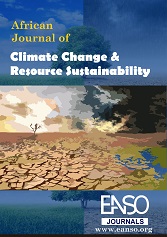A Rapid Literature Review of Climate Financing for Youths in Sub-Saharan Africa
Abstract
Sub-Saharan Africa (SSA), despite contributing the least to global climate change, faces the greatest vulnerability to its effects. Climate finance plays a crucial role in supporting mitigation and adaptation measures, helping communities reduce emissions and enhance resilience. However, without deliberate inclusion, young people (often defined as those aged 15–24 or up to 35 years old) struggle to access the resources needed for their climate initiatives. This study presents a rapid literature review examining the current landscape of climate finance directly accessible to youth in SSA. Employing a rapid search using keywords across academic databases and institutional repositories, the result of 758 papers, necessitated a heavier reliance on institutional reports rather than academic papers due to limited youth-specific climate finance data across academic databases. The review identifies significant gaps in youth-targeted climate finance, characterized by limited age-disaggregated data, a disproportionate focus on mitigation over adaptation, and complex funding mechanisms that exclude grassroots initiatives. Despite youths being critical agents for climate action and disproportionately affected by climate impacts in SSA, financing mechanisms remain fragmented and insufficient. The paper highlights emerging opportunities through blended finance models, enhanced grant access, and private sector engagement, while emphasizing the urgent need for standardized metrics and transparent disbursement mechanisms. Recommendations include a multi-stakeholder approach to prioritize youth representation, streamline funding processes, and ensure equitable distribution of climate finance, advocating for a more direct, inclusive and effective integration of youth in climate finance frameworks.
Downloads
References
African Youth Climate Hub. (2023). AYCH final report 2023: First edition of the incubation program. Retrieved October 2024, from https://youthclimatehub.org/wp-content/uploads/2024/10/Rapport-finale_edition1_incubation-AYCH-22022024.pdf
Biagini, B., & Miller, A. (2013). Engaging the private sector in adaptation to climate change in developing countries: importance, status, and challenges. Climate and Development, 5(3), 242-252.
Brown, J., Cantore, N., & te Velde, D. W. (2010). Climate financing and development: Friends or foes? Overseas Development Institute. https://cdn.odi.org/media/documents/5796.pdf
Chirambo, D. (2016). Integrating Microfinance, Climate Finance and Climate Change Adaptation: A Sub-Saharan Africa Perspective. In: Leal Filho, W. (eds) Innovation in Climate Change Adaptation. Climate Change Management. Springer, Cham. https://doi.org/10.1007/978-3-319-39880-8_12
Wohlin, C. (2014). Guidelines for snowballing in systematic literature studies and a replication in software engineering. In Proceedings of the 18th International Conference on Evaluation and Assessment in Software Engineering (pp. 1–10). ACM Climate Funds Update. (2025). Climate finance flows and architecture: 2025 update. Climate Funds Update. Retrieved from https://climatefundsupdate.org
Climate Investment Funds. (2018). Small loans, big impact: Microfinance and Climate Resilience. https://www.cif.org/news/small-loans-big-impact-microfinance-and-climate-resilience
Commonwealth Secretariat, & YOUNGO. (2023). Availability of climate finance for youth. Commonwealth Secretariat. Retrieved from https://thecommonwealth.org/publications/availability-climate-finance-youth.
Convergence Blended Finance. (2024). The state of blended finance 2024: Convergence report. Convergence. https://www.convergence.finance/resource/state-of-blended-finance-2024/view
Descheemaeker, K., Masikati, P., & MacCarthy, D. S. (2025). Climate change: impacts and adaptation in smallholder farming systems in sub-Saharan Africa. In Pathways to African Food Security (pp. 150-159). Routledge.
Ewolo Bitoto, F., Nchinda Mbognou, C., & Amougou Manga, R. J. (2025). Climate change and income inequality in Sub-Saharan Africa (SSA): effects and transmission channels. International Journal of Development Issues, 24(1), 66-91.
FinDev Gateway. (2022). What Do Microfinance Clients Need to Adapt to Climate Change? Retrieved from https://www.findevgateway.org/blog/2022/04/what-do-microfinance-clients-need-adapt-climate-change
Global Center on Adaptation. (2022). State and trends in adaptation report 2022: Adaptation at the core of a prosperous Africa in an uncertain and warming world. Retrieved from https://gca.org/reports/sta22/
Green Climate Fund. (2020). Guidelines for EDA project development with the Green Climate Fund. Green Climate Fund. Retrieved from https://www.greenclimate.fund/document/eda-guidelines
Hanna, R., & Oliva, P. (2016). Implications of climate change for children in developing countries. The Future of Children, 115-132.
Intergovernmental Panel on Climate Change (IPCC). (2018). Summary for policymakers. In V. Masson-Delmotte, P. Zhai, H.-O. Pörtner, D. Roberts, J. Skea, P. R. Shukla, A. Pirani, W. Moufouma-Okia, C. Péan, R. Pidcock, S. Connors, J. B. R. Matthews, Y. Chen, X. Zhou, M. I. Gomis, E. Lonnoy, T. Maycock, M. Tignor, & T. Waterfield (Eds.), Global warming of 1.5°C: An IPCC special report on the impacts of global warming of 1.5°C above pre-industrial levels and related global greenhouse gas emission pathways, in the context of strengthening the global response to the threat of climate change, sustainable development, and efforts to eradicate poverty (pp. 3–24). Cambridge University Press. https://doi.org/10.1017/9781009157940.001
Lee, K., Gjersoe, N., O’Neill, S., and Barnett, J. (2020). Youth perceptions of climate change: A narrative synthesis. Wiley Interdisciplinary Reviews: Climate Change, vol 11, No. 3, e641.
Hartling, L., Guise, J.-M., Hempel, S., Featherstone, R., Mitchell, M. D., Motu'apuaka, M. L., Robinson, K. A., Schoelles, K., Totten, A., Whitlock, E., Wilt, T. J., Anderson, J., Berliner, E., Gozu, A., Kato, E., Paynter, R., & Umscheid, C. A. (2017). Fit for purpose: Perspectives on rapid reviews from end-user interviews. Systematic Reviews, 6(1), 1–11.
Mahood, Q., Van Eerd, D., & Irvin, E. (2014). Searching for grey literature for systematic reviews: challenges and benefits. Research synthesis methods, 5(3), 221–234. https://doi.org/10.1002/jrsm.1106
Obara, L. M., & Banyard, V. (2025). Understanding resilience in the face of adversity in Kenya: A scoping review. Trauma, Violence, & Abuse, 26(2), 312-326.
Pinchoff, J., Etetim, E. O., Babatunde, D., Blomstrom, E., Ainul, S., Akomolafe, T. O., ... & Austrian, K. (2025). How climate change is shaping young people’s health: a participatory, youth co-led study from Bangladesh, Guatemala and Nigeria. BMJ Global Health, 10(1).
Sanson, A.V., Van Hoorn, J. and Burke, S.E.L. (2019). Responding to the impacts of the climate crisis on children and youth. Child Development Perspectives, vol. 13, No. 4, pp. 201– 207. Available at https://doi.org/10.1111/cdep.12342.
Shishlov, I., & Censkowsky, P. (2022). Same but different? Understanding divergent definitions of and views on climate finance. In Handbook of International Climate Finance (pp. 16-39). Edward Elgar Publishing.
UNICEF. (2023). Falling short: Addressing the climate finance gap for children. UNICEF. https://www.unicef.org/media/142181/file/Falling-short-Addressing-the-climate-finance-gap-for-children-June-2023.pdf
United Nations Development Programme. (2024). Climate finance in Africa: An overview of climate finance flows, challenges and opportunities.
World Economic Forum. (2024). Annual report 2023-2024. World Economic Forum. https://www3.weforum.org/docs/WEF_Annual_Report_2023_2024.pdf
Copyright (c) 2025 Lord Offei-Darko, Noudehouenou Gandonou

This work is licensed under a Creative Commons Attribution 4.0 International License.




























